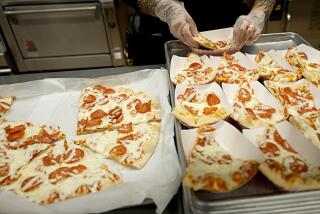FEEDING THE TROOPS
- Share via
In the early 1800s, Napoleon’s army was able to take advantage of a brand-new technology: canning. Since then, food for the troops has gotten steadily better. In the Persian Gulf, front-line solders can eat the next best thing to home cooking--military version.
Generations of American soldiers knew them as C-rations: canned victuals that included such culinary delights as Spam, pork and beans and the beloved fruit cocktail. Today’s U.S. combat troops dine from individual foil-lined plastic pouches called MREs (Meal, Ready-to-Eat) that feature entrees ranging from chicken ala king to spaghetti with meat sauce. Ideally, troops in the field eat only one MRE per day. Field kitchens serving large numbers of troops offer more menu variety. Soldiers in the desert heat must drink 4 to 6 gallons of water per day.
The military is also testing MOREs (Meal, Ordered Ready-to-Eat), which are similar to microwaveable meals found in supermarkets.
MREs: Each foil-lined plastic pouch weighs 1 1/2 pounds and contains several smaller packages of precooked food, condiments, and other items. To avoid monotony and improve nutrition, the military tries not to feed troops MREs for longer than 10 days at a time, although they’ve been field tested for up to 30.
Sample MRE contents:
* pork with rice in BBQ sauce
* applesauce
* jelly
* crackers
* cocoa beverage powder
* spoon
* accessory packet
* Calories: 1,300
* Cost: $3.75
* Preparation: Ready-to-eat, can be heated in hot water, hot sand, on top of a hot engine or under the arm.
* Shelf life: 6 years
OTHER KINDS OF RATIONS
A-rations:
The best, hot meals made from fresh meat, fruit and vegetables (being supplied by the Saudis) prepared at cafeterias away from the front. For those fortunate enough to be close to a hotel, the fare might include “Saudi Champagne:”
Saudi Champagne
* 12-ounces of Perrier
* 12-ounces of apple juice
* sliced apples and oranges
* mixed in a pitcher, serve chilled B-rations:
Industrial-size cans of foods and dehydrated meat and eggs served aboard ship, at cafeterias or at mobile kitchens in the field. B-rations are often supplemented with fresh meat and produce.
T-rations (tray rations):
Available in 20 menus. One tray-pack module provides enough food and utensils for 36 soldiers, supplying a larger variety of food than MREs. Containers are placed in hot water and can be served buffet style from temporary tents and mobile kitchens in the field. Tray Ration sample menu:
Sample Lunch or Dinner:
* chicken cacciatore
* potatoes diced in butter sauce
* green beans
* chocolate pudding
* lemon-lime beverage powder
* peanut butter, jelly
* 5 compartment plate
* 8 oz cup.
* accessory packet*
* Accessory packet includes: coffee, cream substitute, sugar, salt, matches, toilet tissue, chewing gum, towelette, candy or bottle of hot sauce.
THE FOOD BILL
The military is spending about $4.5 million per day to feed the troops in the Mideast. The total grocery bill since Iraq’s invasion of Kuwait adds up to $850 million. Food orders include:
12 million heat-resistant chocolate bars: $5.6 million
51 million packets of instant coffee: $2 million
51 million packets of non-dairy creamer: $469,200
6.8 million pounds of sugar: $2.5 million
5.1 million pounds of flour: $2.09 million
299.1 million packets of salt: $927,722
2.4 million pounds of coffee: $3.4 million
TOP FOOD CONTRACTORS
Almost a third of all the food budget is going to four companies. $62 million: Oregon Freeze Dry, Albany, Ore.: Freeze-dried meat
$55 million: Vanee Foods Co., Berkeley, Ill.: Vacuum-packed “T-rations” that include canned pudding, sausage links and lasagna.
$44.6 million: Geo. A. Hormel Co. Austin, Minn. (Top Shelf meals): For use in MREs. Entrees include, Beef Sukiyaki and glazed breast of chicken.
$14 million: Fisher Foods Ltd., Lincoln, Neb.: Dehydrated scrambled eggs.
More to Read
Eat your way across L.A.
Get our weekly Tasting Notes newsletter for reviews, news and more.
You may occasionally receive promotional content from the Los Angeles Times.







